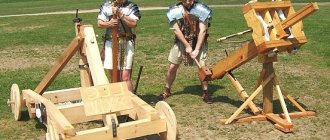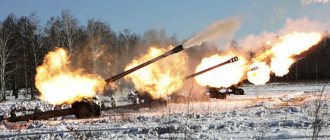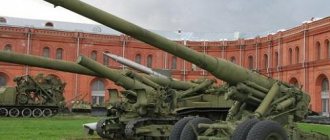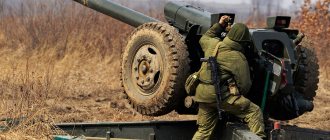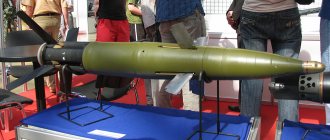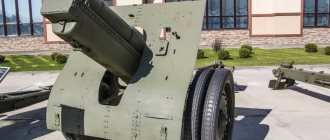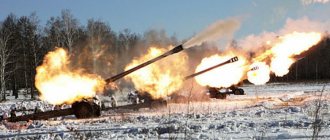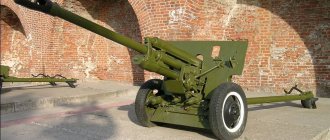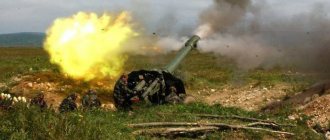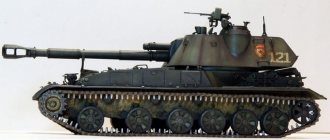15cm sFH18 is a German heavy field howitzer from the Second World War. This howitzer was in the staff of one of the four artillery regiments of the infantry division, along with the 10.5 cm leFH18, which were in the other three divisions. The same howitzer was in the staff of individual heavy artillery divisions of the RGK. 150-mm sFH18 howitzers were widely used to destroy enemy personnel, counter-battery combat, as well as combat tanks in initial positions, as well as destroy long-term fortifications and shelling the enemy’s rear.
Appearance bases 15cm sFH18.
As you know, one of the clauses of the Treaty of Versailles directly prohibited Germany from developing, building and having in service artillery guns with a caliber of 150 mm or more. With the only exception, the artillery of the Königsberg fortress was able to retain twelve 15cm lg field howitzers. sFH13
Naturally, this situation did not suit the German military. Secretly from the Allies, they hid quite a significant number of lg.sFH13 howitzers. In 1939, the Wehrmacht had 696 howitzers of this modification. Even before the International Control Commission completed its work in Germany, the German military raised the question of resuming mass production of heavy howitzers. However, the existing howitzer no longer met modern requirements, primarily due to insufficient range, as well as the angle of horizontal fire.
The designers and Krupp began work on the future 15cm sFH13 howitzer several months before the departure of the control commission. This time, by decision of the Army Weapons Department, the competitors worked together. was responsible for designing the howitzer barrel, while Rheinmetall designed the carriage. In order to maintain secrecy, the new howitzer received the index 15cm sFH18, i.e. a 150-mm heavy field howitzer model 18g. Work on the howitzer, including design, production of prototypes, and testing, lasted about three years.
Performance characteristics of mortars 21 cm Mrs 18.
| 21 cm Mrs 18 | |
| Trunk | |
| Caliber, mm. | 210,9 |
| Barrel length mm/club. | 6510/31 |
| Pipe length, m. | 6080/29 |
| Length of threaded part mm | 5274 |
| Length of charging part, mm. | 643 |
| Charging chamber volume, l. | 2,45 |
| Rifling steepness, club/gr.: | 36/30 |
| Number of rifling | 32 |
| Depth of rifling, mm. | 2,4 |
| Cutting width, mm. | 5,6 |
| Field width, mm. | 3,9 |
| Weight of the barrel with bolt, kg. | 5990 |
| Carriage | |
| UVN | -00 to + 700 |
| UGN | |
| without rearranging the trunk | 160 |
| with trunk repositioning | 3600 |
| Rollback length, mm. | |
| short | 850-1200 |
| long | 950-1000 |
| Weight of the system in combat position, kg. | 16700 |
| Weight of the system in the stowed position with undivided carriage, kg. | 17900 |
| Weight of the system in the stowed position on two carts, kg | 22700 |
| Rate of fire, rds/hour. | 30 |
| Booking speed with separate carriages, km/h. | up to 20 |
Ballistic data 21 cm Mrs 18.
| Charge No. | High-explosive fragmentation projectile weighing 113 kg. | Concrete-piercing projectile weighing 121.4 kg. | ||
| Initial speed, m/s | Firing range, m. | Initial speed, m/s | Firing range, m. | |
| 1 | 225 | 4650 | 218 | — |
| 2 | 256 | 5850 | 247 | — |
| 3 | 290 | 7325 | 281 | — |
| 4 | 355 | 9800 | 344 | — |
| 5 | 440 | 12500 | 426 | — |
| 6 | 565 | 16700 | 550 | 16700 |
Background of creation
According to the terms of the Versailles Peace Treaty, from March 31, 1920, Germany could not have more than seven infantry and three cavalry divisions, and the total strength of its army should not exceed 100,000 people, including officers and civilians. The total number of officers, including headquarters personnel, should not have been more than 4,000 people. The General Staff was disbanded and could not be restored in any form. Universal compulsory military service was abolished, and the army could only be recruited voluntarily.
Parade of German troops in defeated Warsaw, autumn 1939. Passage of sFH 18 horse-drawn: in the foreground - a barrel cart, in the distance - a gun carriage. All-metal wheels (Bundesarchiv)
Artillery was seriously reduced. Each infantry division was supposed to have one artillery regiment of three divisions of 12 guns each, with two divisions armed with cannons and only one with howitzers. Not only the number of guns was limited, but also their type and caliber: thus, 105 mm light howitzers were specified. The cavalry divisions did not have howitzers at all.
The Germans were forbidden to develop any new weapons systems, but after some time work began - secretly or outside Germany. It was also forbidden to have heavy artillery, but there was a small exception - the fortress region of Königsberg. It was allowed to retain a small number of heavy guns, namely 150 mm field howitzers of the 1913 model (15 cm sFH 13), belonging to one of the most common types of heavy guns of the Imperial German Army.
Officially, it was allowed to keep 12 sFH 13 howitzers with 400 rounds of ammunition per barrel, but in reality there were more guns: the Germans managed to hide something, including 210-mm mortars. This made it possible to train artillerymen of infantry divisions and create the personnel backbone of the heavy artillery of the future Wehrmacht.
150 mm heavy field howitzer sFH 13 and its crew
To monitor the implementation of the terms of the Treaty of Versailles, an allied control commission, consisting of 337 officers and 654 soldiers, worked in Germany. The commission noticed new developments and even closed the design bureau of the Krupp concern, which was leading in the industry. Nevertheless, the work was continued by the same engineers literally in the neighboring town. The commission left Germany on February 28, 1927, after which there was no particular need to hide.
Modifications 15cm sFH18
In 1942, the 15cm sFH18M . The main difference of this modification was the muzzle brake and barrel liner. Thanks to these changes, it was possible to reduce the load on the carriage when firing with charges No. 7 and 8 and made it possible to change the table liner, rather than the barrel itself, as it wears out.
The 15cm sFH18M was the first German gun to include active rockets in its ammunition load. The 15cm RGr projectile weighing 45.25 kg made it possible to fire at a distance of up to 19 km, thanks to which the howitzer was able to fire at targets previously only available for 10.5 cm K18 guns. This made it possible to abandon the production of these guns, although active-missile projectiles, due to imperfections in their design, had a large dispersion. So at the maximum distance the dispersion of shells reached 1250m.
In 1935, at the direction of the Armaments Department and Krupp, the design of a light 150-mm howitzer began. The main goal of the project is to ensure the transportation of the howitzer with a single six-window harness. The lightweight howitzer received the index 15cm sFH36 . The main difference is the DT barrel shortened by 890 mm and the widespread use of light alloys. The weight of the howitzer was reduced by almost half, to 3500 kg, while it was necessary to reduce the firing range to 12.5 km. The 15cm sFH36 prototype was made in 1938; small-scale production of lightweight howitzers began in 1939. But already in the forty-first year, production had to be stopped due to a shortage of light alloys that were required for the aviation industry.
The design of another version of the 15cm sFH18, specifically for mechanical thrust, began in 1938. In this version, thanks to an increase in barrel length by three calibers, it was possible to increase the range to 15.6 km. The UVN has been significantly increased - up to 70 degrees. This modification received the index 15cm sFH40 . The prototype was released already in 1938, but production of the sFH40 was blocked due to the need to force an increase in the production of existing artillery systems. All work on this modification was stopped in the forty-first year.
They decided to work out the existing stock of barrels by placing them on a serial sFH18 carriage. The resulting 15cm sFH18/40 or 15cm sFH42 turned out to be a not entirely successful weapon. A longer table compared to the sFH18 increased the firing range, but the standard carriage did not allow firing along such high trajectories as the sFH40. The price of the gun was 60 thousand Reichsmarks versus 40 thousand for the sFH18. A total of 46 such howitzers were produced.
In the hands of the winners
After the war, Skoda modernized the sFH 18 for the needs of the Czechoslovak army, unifying the howitzer with Soviet guns in terms of ammunition. The gun became known as 152 mm houfnice vz. 18/47: a new barrel with a muzzle brake was installed on the sFH 18 carriage. This modification was in service with the Czechoslovak army until the end of the 80s of the last century, and some of the barrels were used for installation on the vz self-propelled howitzer. 77 DANA (Samohybná Kanónová Houfnice vzor 77).
Czechoslovakian 152 mm houfnice vz. 18/47. Technical Museum Leschany (Czech Republic)
During the war, the Red Army captured a number of sFH 18s, and the Main Artillery Directorate tested them. Based on the test results, a detailed description of the howitzer was compiled, and the following design features were considered worthy of attention:
- mechanisms for fastening the recoil device shields in the breech;
- method of attaching a hydraulic knurl to an air knurl;
- lower machine design;
- chassis design;
- placement of the lifting mechanism flywheel on the frame.
However, the overall conclusion was negative:
“In production, the system, due to the complexity of a number of mechanisms, the difficulty of processing some parts and components, and the large number of riveted joints, does not have sufficient simplicity. This makes it not fully suitable for mass production. However, the system still cannot be called complex in terms of production.”
Shells and cartridge cases with charges for the sFH 18 howitzer
Tactical and technical characteristics of the sFH 18 howitzer:
Work on new 150 mm howitzers.
In September 1943, the Wehrmacht High Command announced a competition for the design of a 15cm sFH43 field howitzer with all-round fire and increased air pressure to seventy degrees. In addition to the traditional players Krupp and Rheinmetall, Skoda took part in this competition. The main intrigue was to destroy the ML-20 howitzer guns per kilometer. Not a single presented project could satisfy the military. The following year, a new competition was announced, with new performance characteristics for the 15cm sFH44. But these projects were not implemented either.
Design Features
When designing the 10.5 cm leFH16 howitzer, much attention was paid to maintainability, unification and interchangeability of components and individual components, taking into account the possible supply and replacement of worn-out parts. So, for example, the howitzer and the Model 16 gun used the same 98/09 howitzer carriage with some changes and strengthening of the design. Further, in the recoil mechanism, it was possible to use a uniform Felda 16 compressor with constant recoil. This was a particularly important measure, since it ensured complete interchangeability.
To achieve the previously specified firing range, the barrel of the 10.5 cm leFH16 was significantly lengthened - the howitzer barrel was increased by as much as 10 calibers - from 11.9 to 22. At the same time, the howitzer lost the typical feature of a gun with a steep trajectory (short barrel) that was typical at that time. and took the form of a cannon - a phenomenon that was equally repeated with heavy guns. The howitzer received a new vertical wedge breech and retained the progressive rifling of the barrel.
Thus, the 10.5 cm leFH16 howitzer was not a completely new design weapon, but represented a further consistent development of the previous material part of the German artillery. It was largely based on data from existing material. For example, there is the issue of caliber, which was retained in order to use stockpiled ammunition. Not unimportant was also the possibility of using equipment and equipment already available at the factories.
